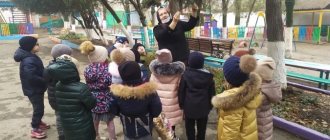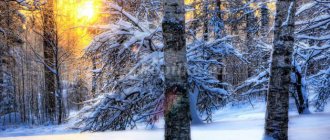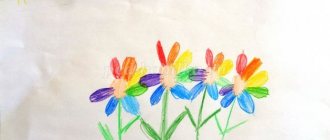Spring dimension
Its goal is to continue acquaintance with various natural phenomena, improve the ability to distinguish weather, and connect it with the features of the sky.
The outline of a walk in the middle group in the spring includes the development of children's attentiveness, maintaining a gracious, joyful, excellent mood, and the formation of concepts about the changing seasons.
Spring walk - observation in kindergarten with middle group children
Summary of a walk in kindergarten in the spring.
Middle group. Observations of the first thawed patches Author: Vitskova Marina Viktorovna, teacher of the MBDOU “Kindergarten “Golden Fish” of the Astrakhan region, Chernoyarsk district. Description: Using this material, children develop observation, curiosity, and attention. This material will be useful for parents and kindergarten teachers when conducting spring walks for middle school children. Topic: “Observing the first thawed patches” Objectives: to develop the ability to find the first signs of spring in the surrounding nature; establish connections between changes in inanimate nature, develop observation skills, and the ability to analyze. Materials: spatulas, buckets, molds, children’s toys for independent activities.
Progress of the walk
Observation of thawed patches.
Educator. Guys, today we will watch the snow melting in different places in the kindergarten area. Show places where snow and ice melt faster. These are the first thawed patches of spring. They appear where the snow warms up better and melts. Thawed patches appear in early spring, when the frosts have not yet completely subsided, and the warm breath of March is already beginning to be felt. Spring is coming towards us with quick steps And the snowdrifts are melting under its feet Black thawed patches are visible in the fields You can see the very warm feet of spring. Educator. Children, what are thawed patches ? (Children's answers) Educator. Thaws are a small area thawed from snow, most often around trees. It seems to many that thawed patches symbolize new life and hope, because they are the first news of spring along with the joyful singing of birds. Educator. Children, what signs do you know about spring ? Children. In spring, day and night are measured and equal. If in early spring the clouds float quickly and high, expect good weather. Frequent fogs in March foreshadow a rainy summer. A dry March means fertility, a rainy March means crop failure. When in the spring the snow melts quickly and the water runs smoothly - towards a wet summer . Educator. Well done, children. Now tell us proverbs and sayings about spring . Children. March is a brother of spring and winter; In March it melts early - it won’t melt for a long time. In spring the rain steams, in autumn it wets. Fear autumn - winter will follow, do not be afraid of winter - spring will follow. Spring is not complete without the first swallow. Whoever works hard in the spring will have fun in the fall. After the most severe winter, spring will still come. In the spring, if you tighten the plowing, you will stretch your legs. Spring is our father and mother; whoever sows will not reap. He who sleeps in spring cries in winter. Prepare the sleigh in the spring and the wheels in the fall. Educator. Well done. Now listen to a poem about spring If the snow is melting everywhere, The day is getting longer, If everything is green and the stream is ringing in the fields, If the wind has become warmer, If the birds can’t sleep, If the sun is shining brighter, It means spring has come to us. Educator. Guys, guess the riddle.
Mystery.
On the river in winter the parquet is durable, slippery, smooth.
At least dance on it for a hundred years! Waltzes and squats. The cold has passed - He disappeared then... Children. This is ice. Educator. That's right, well done.
Now we'll play. A didactic game is being held: “What can’t spring be without?”
Goal: to practice selecting nouns and correct word agreement. Spring cannot exist without... (bright sun). Spring cannot exist without...(puddles). Spring cannot exist without... (streams). Spring cannot exist without... (thunderstorm). Spring cannot exist without...(chafer beetles). Spring cannot exist without... (thawed patches). Spring cannot exist without... (drops). Spring cannot exist without...(snowdrops). Labor activity. “Cleaning up toys” Purpose: to attract children to perform simple tasks. Individual work Development of movements - practice running at speed, improve the technique of standing long jump.
The outdoor game “Homeless Hare” is being played.
Goal: run fast; navigate in space. Progress of the game: A “hunter” and a “stray hare” are selected. The rest of the “hares” stand in hoops - “houses”. The “homeless hare” runs away, and the “hunter” catches up. The “hare” can stand in the house, then the “hare” standing there must run away. When the “hunter” catches the “hare,” he himself becomes the hare, and the “hare” becomes the “hunter.” Independent activity of children.
Summary of the walk.
Educator. Guys, what did we talk about today? What interesting things did you learn? What else would you like to know? (Children's answers)
We recommend watching:
Summary of GCD on speech development in the middle group on the topic: Spring GCD in the middle group of kindergarten on the topic: Spring. Cognitive development Summary of educational activities on speech development “Spring has come” for children of the middle group Summary of educational activities for the middle group of kindergarten on the topic: Spring
Similar articles:
Summary of the lesson “Wild animals in spring” in the middle group
Summary of a spring walk in the middle group
Progress of the walk
The summary of the target walk in the middle group in the spring includes the kids guessing riddles:
“What kind of ceiling is this that is neither low nor high? It is gray and whitish, sometimes beautiful, sometimes sad (the sky).” Next, the teacher invites the kids to look at it and evaluate the day. Kids select adjectives for the state of the sky: sad, blue, gray, sad, happy.
In the summary of a walk in the middle group in the spring, you can include the following speech for the teacher: “Guys, if the sky is blue, what will the weather be like?” The kids answer that if there is sun in the sky, the weather will be warm and joyful. Gray skies suggest a sad and cloudy mood, a sad day.
Next, the teacher asks his students on what day they most want to go for a walk, and why? The teacher offers the preschoolers a poem:
What's happened? What's the matter?
The sky suddenly turned blue,
Suddenly the evil cold went away...
There are still puddles in the yard...
Who is to blame for everything here?
Of course, the month is March.
The teacher asks the kids about what time of year is mentioned in this poem. Preschoolers answer the teacher that we are talking about spring. Next, the teacher asks questions:
- What other months do you know?
- What characterizes each month?
- What are the signs of spring?
- Where does the snow go?
- Why does it get warm in spring?
Next, the kids are shown the “Find a thawed patch” experiment. Its goal is to consolidate the properties of snow, develop observation skills, and develop cognitive interest in natural phenomena. In the area of the kindergarten designated for walking, the children, together with the teacher, look for thawed patches. They are trying to understand why they appear in these places. The teacher leads the children to the conclusion that thawed patches appear only where the bright sun shines. Next, the teacher conducts an entertaining experience for his students. He puts some of the snow in a sunny place and leaves some in the shade. The kids, together with their teacher, carefully observe the changes that occur with the snow and draw conclusions about the influence of temperature on the process of snow melting.
Summary of a walk in the spring in the middle group
Summary of the walk “Observing icicles” for children of the middle group
Author: Vitskova Marina Viktorovna, teacher of the MBDOU “Kindergarten “Golden Fish” of the Astrakhan region, Chernoyarsk district. Description: using this material, children develop observation, curiosity, and attention. This material will be useful for parents and kindergarten teachers when conducting spring walks for middle school children. Goals: to generalize and deepen ideas about spring based on essential features (inanimate nature). Objectives: consolidation of knowledge about natural phenomena. nurturing curiosity and aesthetic perception. Materials: buckets, spatulas, molds, children's toys.
Progress of the walk:
Observation of icicles. Educator. Children, please look carefully at the roofs of the houses. What do you see there? Children. We see icicles Educator. All winter long an icy long nose grew on the roof. He looked down from the cornice And prepared a surprise for everyone - Ringed in April with the Music of a drop: Ding! Ding! Ding! Ding! Ding! Ding! Turning into blue puddles, the beauty of the little Ice-icicle melts. Educator. On the roofs of houses we see a beautiful fringe of icicles that fall during the day and break on the ground into small ice fragments. Guys, why do you think they melt during the day? And why don’t icicles melt from all sides of the roof? (Children's answers) Educator. Children, can you get close to places where there are icicles? Children. It is forbidden! Educator. That's right, no, get close to those places where at any time an icicle can fall right on you. At home, you need to ask your parents to remove the icicles at the entrance, otherwise trouble will come. In winter, icicles hang from the roofs, It’s better not to walk under them. An icicle can fall from the roof and hit a person. Educator. Children, do you know any signs about icicles, tell us? Children. “Long February icicles promise a long spring” “If in the spring icicles form on the roofs of a house when the snow melts, it means a long spring.” Long icicles in the spring - a long spring and long weather. Educator. Children, what is an icicle? Children. An icicle is a piece of ice hanging from the roof of a house. Educator. An icicle is a liquid that has become icy during drainage in the form of an elongated cone.
Poem.
Why is the icicle crying and shedding tears at our dacha? Winter just ended, in March everyone at home is crying.
Mystery.
It hangs under the roof, if you break it, it crunches.
In winter it freezes, A tear does not flow, The sun will burn - It will cry, it will flow... Children. Icicle Labor activity. “Remove ice from the paths” Goal: attract children to perform simple tasks. Individual work:
“Jump over the stream”
Goal:
Improve standing long jumps.
Game activity.
An outdoor game is played: “Ice, wind and frost.” Children stand in pairs facing each other, knock their palms and say:
Cold pieces of ice, Transparent pieces of ice. They sparkle and ring: Ding! Ding! Ding! When the teacher says “wind,” the children run away to the sound of a tambourine. For the word “frost” they build ice blocks.
Independent activity of children.
Educator. Children, our walk with you has come to an end. Tell me what you did? What new did you learn? Would you like to learn something new? (Children's answers)
We recommend watching:
Spring walk - observation in kindergarten with middle group children
Similar articles:
Summary of a spring walk in the middle group
Seasonal walk. Spring. Middle group.
Equipment: ball, shovels, bird treats, hare mask, hoop with ribbons, cones, box of candy.
Progress of the walk.
Guys, I want to ask you a riddle:
The sun is warming up The snow is melting When does this happen?
That's right in the spring! And what month of spring now rules, as it is called, the very first month of spring. Child:
Mother Spring is coming Open the gates March came first The white snow has melted
And what other month can this month be named according to the folk calendar? (pre-spring, protalnik) Who wants to tell a poem about the month of March. Child:
Although March is a crybaby And a big cunning One eye is in tears And in the rays of the other.
And what do you and I know about the first signs of spring?
(the teacher throws the ball to the children in a circle)
• Drops are ringing • Melt water • Thaw • Blue sky • Daylight increases • Thaws • Birds rejoice • The sun shines brightly • Icicles
-Let's ask how spring is doing? Q: How's spring going? D: I have cleaning to do. Q: What do you need a broom for? D: Sweep the snow from the hillock. Q: What do you need streams for? D : Wash away the trash from the paths. Q: What do you need the rays for? D: Same for cleaning. Q: The sun is working, helping spring. Let's remember the proverbs about work. D: You’ve done the job, walk boldly. You won’t be able to pull a fish out of the pond without difficulty. Let's take shovels and help the snow melt (Children's work at the site with a teacher) Educator: The rays of the sun are warm and nimble. They grew up and began to ask the sun to let them go for a walk on the ground. The sun thought and released rays. The baby's rays scattered to visit the children.
The children walked around the yard, watched nature, looked up at the sun, and their rays warmed them.
Pull up your palms, feel how the little rays caress and warm your hands. They are the ones who greet you. Show them your rays. Let the warm rays warm them. The rays also hit the birds. Let's put some bread crumbs in their feeder. But they won't be coming soon. How can you figure out why? Children: They will find their own food, because spring has come and they feel warm and happy. Educator: A ray of sunshine hit the bunny.
Let's play the game "Grey Bunny Wash Yourself"
Guys, if you want to ride the carousel with me, look how wonderful the spring weather is today.
Game "Carousel" (ribbons attached to the hoop)
Barely, barely, barely the carousel spun And then, then, then everyone ran, ran, ran. Hush, hush, don't write off the carousel, stop it. One-two, one-two The game is over.
Educator: I have a surprise for you. But only then will you receive it when you hold hands and walk like a snake between the cones. Be careful and walk carefully.
(cones are scattered throughout the area)
Children find a box of sweets.
Educator: Let's all say together: Come spring, come beauty, come on, sunshine, little bell! Children, now we will draw what interesting things we learned on our walk today or what we remembered and liked most.
Author: Zoya Viktorovna Ovchinnikova, teacher, MBDOU d/s “Luchik” combined type, Bolkhov, Oryol region, Russia
The article is published in the author's edition



